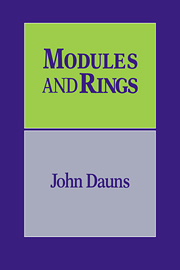Book contents
- Frontmatter
- Contents
- PREFACE
- NOTE TO THE READER
- CHAPTER 1 MODULES
- CHAPTER 2 FREE MODULES
- CHAPTER 3 INJECTIVE MODULES
- CHAPTER 4 TENSOR PRODUCTS
- CHAPTER 5 CERTAIN IMPORTANT ALGEBRAS
- CHAPTER 6 SIMPLE MODULES AND PRIMITIVE RINGS
- CHAPTER 7 THE JACOBSON RADICAL
- CHAPTER 8 SUBDIRECT PRODUCT DECOMPOSITIONS
- CHAPTER 9 PRIMES AND SEMIPRIMES
- CHAPTER 10 PROJECTIVE MODULES AND MORE ON WEDDERBURN THEOREMS
- CHAPTER 11 DIRECT SUM DECOMPOSITIONS
- CHAPTER 12 SIMPLE ALGEBRAS
- CHAPTER 13 HEREDITARY RINGS, FREE AND PROJECTIVE MODULES
- CHAPTER 14 MODULE CONSTRUCTIONS
- CHAPTER 15 CATEGORIES AND FUNCTORS
- CHAPTER 16 MODULE CATEGORIES
- CHAPTER 17 FLAT MODULES
- CHAPTER 18 PURITY
- APPENDIX A BASICS
- APPENDIX B CERTAIN IMPORTANT ALGEBRAS
- LIST OF SYMBOLS AND NOTATION
- BIBLIOGRAPHY
- SUBJECT INDEX
- AUTHOR INDEX
PREFACE
Published online by Cambridge University Press: 20 October 2009
- Frontmatter
- Contents
- PREFACE
- NOTE TO THE READER
- CHAPTER 1 MODULES
- CHAPTER 2 FREE MODULES
- CHAPTER 3 INJECTIVE MODULES
- CHAPTER 4 TENSOR PRODUCTS
- CHAPTER 5 CERTAIN IMPORTANT ALGEBRAS
- CHAPTER 6 SIMPLE MODULES AND PRIMITIVE RINGS
- CHAPTER 7 THE JACOBSON RADICAL
- CHAPTER 8 SUBDIRECT PRODUCT DECOMPOSITIONS
- CHAPTER 9 PRIMES AND SEMIPRIMES
- CHAPTER 10 PROJECTIVE MODULES AND MORE ON WEDDERBURN THEOREMS
- CHAPTER 11 DIRECT SUM DECOMPOSITIONS
- CHAPTER 12 SIMPLE ALGEBRAS
- CHAPTER 13 HEREDITARY RINGS, FREE AND PROJECTIVE MODULES
- CHAPTER 14 MODULE CONSTRUCTIONS
- CHAPTER 15 CATEGORIES AND FUNCTORS
- CHAPTER 16 MODULE CATEGORIES
- CHAPTER 17 FLAT MODULES
- CHAPTER 18 PURITY
- APPENDIX A BASICS
- APPENDIX B CERTAIN IMPORTANT ALGEBRAS
- LIST OF SYMBOLS AND NOTATION
- BIBLIOGRAPHY
- SUBJECT INDEX
- AUTHOR INDEX
Summary
In his or her journey through the book, how is the novice reader to identify the major results, which are like milestones marking one's progress along the way? First of all, some of them carry special names. Thus items named after a person are important, e.g. Wedderburn Theorems, Baer criterion, Jacobson's radical, Schanuel's Lemma, Fitting's Lemma, Krull-Remak-Schmidt Theorem, etc. To further help the reader, the paragraph headings “theorem”, “proposition”, and “construction” are used infrequently as opposed to the more numerous usage of “lemma”, “corollary”, “consequence”, “observation”, an unlabeled paragraph, and “remark”. Here these terms are in descending order of importance, “theorem” being the most and “remark” the least important. In order to especially facilitate the actual identification of major results, the word “theorem” in this book is used more sparingly than in any comparable text known to the author. For example, with the exception of the preliminary review of basics in Chapter 0, the first time this word occurs is in Chapter 3 (in 3–3.3). In this particular case, it deserves the name “theorem” because it is a result that is difficult to prove, not at all obvious, but a result which once grasped is like an open passageway allowing free and easy access to the whole theory of injectivity. Also, it (Theorem 3–3.3) is an important and useful tool in more advanced module theory. Here in this text, also the word “proposition” marks significant mathematical statements and is used grudgingly.
- Type
- Chapter
- Information
- Modules and Rings , pp. xi - xviPublisher: Cambridge University PressPrint publication year: 1994



